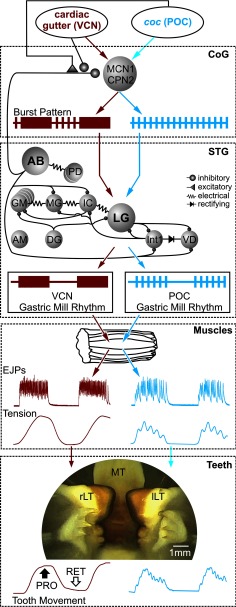Figure 10.
The distinct gastric mill motor patterns elicited in the isolated STNS by different extrinsic inputs drive comparably distinct patterns of EJPs and muscle tension in semi-intact preparations and lateral tooth protraction movements in vivo. In the isolated STNS, stimulating the VCN or POC pathways triggers long-lasting activation of the same two projection neurons (MCN1, CPN2), which then exhibit VCN-specific and POC-specific burst patterns (shown schematically; CoG). These different patterns result at least partly from differential presynaptic regulation of AB neuron feedback to these projection neurons. The distinct projection neuron activity patterns drive different gastric mill motor patterns from the gastric mill CPG, including different burst patterns in the LG protractor neuron (shown schematically; STG). Note that the MCN1/CPN2 synaptic actions on the gastric mill CPG are omitted for clarity. The CoG and STG summaries are based on previous work (Coleman and Nusbaum, 1994; Norris et al., 1994; Beenhakker and Nusbaum, 2004; Stein et al., 2007; Blitz and Nusbaum, 2008, 2012; White and Nusbaum, 2011). The different LG burst patterns were retained by the LG-innervated muscles at the EJP and tension levels, despite these muscles having slow contraction and relaxation dynamics (Muscles), and by the lateral tooth protraction movements (Teeth) after triggering chewing patterns by mechanically stimulating the cardiac gutter (VCNs) or electrically stimulating the coc (POC neurons). EJPs, tension, and tooth movement traces are from actual recordings obtained for this paper. The image of the protracted teeth shows a screenshot from the endoscope camera. rLT, Right lateral tooth; lLT, left lateral tooth. Colored arrows indicate the flow of information from the extrinsic inputs through the STNS to the muscles and teeth.

